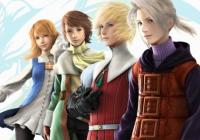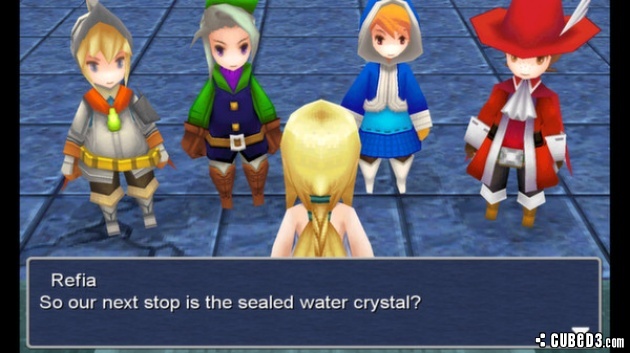Final Fantasy III (PC) Review
By Gareth F  16.07.2014
16.07.2014

In an age where realistic, ultra-violent video games are consumed by the masses and considered to be a relatively mainstream form of entertainment it's safe to say that the art form has slowly lost its innocence over the years. It's hard pinpointing the exact moment when the populace slipped from being shocked and outraged to merely accepting it as the norm with a collective shrug of the shoulders but gaming, alongside music and video, have all contributed to the gradual numbing down of society. Twenty four years ago Final Fantasy III, a game that embodies an era of purity and simplicity, was the product of an entirely different gaming industry to the one that exists today, one that nobody could have foreseen evolve into the multi-billion dollar business it is now. Flash-forward back to the present and it seems that any game released that either embraces the gameplay mechanics or the lo-fi aesthetics of some of these ancient, old school classics actually feel remarkably fresh and original when compared to the glut of shooters that currently clutter the marketplace. However, how would a genuine throwback like Final Fantasy III fare when tossed into the arena against games that could claim to be one its descendants?
For those unaware of the history behind Final Fantasy III, it first emerged nearly a QUARTER OF A CENTURY ago as a Japanese-only release on the NES (just let that sink in for a moment) and whilst certain people may have a recollection of playing it on the SNES, it turns out that this was actually a localised version of the Japanese Final Fantasy VI, an entirely different game altogether. Confused? Well, to further muddy the waters, Square Enix decided to revisit the original Japanese NES version in 2006 knowing that there was a sizable Western audience that was previously unaware of its existence, and so released an enhanced version of it for the DS, which eventually wormed its way into the hearts of the many that played it (and again on mobile phones a few years later).
The paper thin, almost non-existent story begins with an introduction to Luneth, an orphan who has seemingly found himself stuck in a set of caves, as was a common occurrence for a lot of kids starting out in the videogame industry. After battling his way through to the exit, he is confronted by an oversized talking crystal (the possible result of a radioactive leak near a jewellery shop) that proceeds to inform him in no uncertain terms that he is 'The Chosen One.' Whilst mulling over this revelation, Luneth makes his way to the nearby town and after chatting to a few of the friendly, one-dimensional natives, it soon becomes apparent that something is amiss in this fair land they call home. Luckily, one by one, a small posse of like-minded individuals who also happen to be orphans lumbered with similarly bizarre monikers (namely Ing, Arc and Refia) join Luneth in a quest to help a neighbouring town overcome its Djinn problem. A few scrapes later and the evil Djinn is despatched, bringing with it a vague sense of normality for the townsfolk but more problems for our hapless quartet. Another encounter with the overly chatty Crystal of Light rounds off a fairly busy day for the heroes, with it informing them that they have ALL been chosen for a mission to bring back balance to the world via exploration and copious amounts of incessant grinding, and it is HERE where the adventure begins…
First things first, the combat in Final Fantasy III utilises what would be referred to nowadays as a traditional turn-based system that was likely deemed cutting edge back when the game released but seems somewhat archaic and clunky when armed with the knowledge that the same system has been refined, tweaked and expanded on greatly over the years. Getting into the first of many battles feels a little bit like rediscovering a comfortable pair of shoes that have long since fallen out of favour in that, whilst they feel familiar and invoke fond memories of the last time they were worn, it doesn't take long for the realisation to sink in that comfort alone doesn't a great shoe make. Clumsy footwear similes aside, it gets slightly more interesting with the introduction of jobs, giving each of our protagonists an additional skill set for use in battles (and occasionally during exploration) that levels up with usage and become progressively more effective the longer they are active. A Thief will get the opportunity to steal items from opponents, a Summoner can draw the hidden powers of summon beasts, a White Mage specialises in healing, a Black Mage in the darks arts of offensive magic, and so on, and so forth.

New jobs do get offered at select points during the course of the game, although switching profession will incur a temporary penalty that can have an impact on the gangs' potency against the increasingly tougher enemies. There's one fairly major discrepancy with the combat system in that there is no visible on-screen indication as to what level the enemy / enemies are that are about to be clashed with, let alone how much health they have remaining during a battle. As a result of this, the Crystal of Light gang will often, without warning, get totally wiped out on a fairly regular basis and it gets a bit tiresome when there are no obvious signs whether it's a battle that should be fought or fled from. Being forced to refer to the ever helpful GameFAQs website for the first time in years just to get an indication on how to progress the caves inhabited by the Djinn felt like a small failure on a personal level, but it indicated that the current characters needed to be three levels higher if survival was on the agenda. The grind starts here. Luckily, the attacks come thick and fast, mainly down to the random factor in which they occur, but it still felt like an eternity of walking around the woods, getting attacked, spamming the 'ENTER' key, defeating the attackers, rinse … repeat … rinse … repeat ... until every single one of those orphaned heroes had hit the level that would keep their frail health in check ... until, of course, the next plateau to grind towards cropped up *shakes fist at dragon*
The towns in Final Fantasy III act as a brief respite from the constant attacks that beset the team's travels, as well as provide the ideal place to stock up on or sell surplus weapons, armour, potions, and spells. That's not to say that items won't be found during exploration as there are treasure chests scattered near enough everywhere visited, anxious for players to relieve them of their contents. The story, as was inferred earlier, is a bit thin on detail and the only snippets of story / direction obtained is derived from interacting with the folk that inhabit the towns who are seemingly doomed to repeat the same lines over and over again like a 16-bit version of Groundhog Day. Some of these characters will dish out side missions and whilst completionists will want to tackle everything that's thrown at them, on occasion the rewards don't seem worth the hassle.
As might be expected from such an old game, a few features that are nowadays taken for granted are conspicuous by their absence, with the most notable one being the omission of an auto-save. Having learnt this fact the hard way, it's definitely advisable to get into the habit of making a progress save every few battles as it only takes one minor slip up to hit re-grind territory. Playing through this without the rose tinted spectacles of somebody who enjoyed it on the DS makes it very easy to pick out some of the minor annoyances, but for a 24-year-old game it's not too hard to overlook these shortcomings. Modern gaming is making gamers soft and it's good to occasionally be reminded about how easy things are nowadays. Of course, those amongst Cubed3's readers who are already veterans of the DS version will be all too aware of these creaky mechanics, so such gripes can be dismissed, but it's hard to deny that the gameplay itself is far better suited to a handheld than a PC.

Cubed3 Rating
Good
Final Fantasy III certainly oozes charm and it has plenty of heart, so it's easy to understand why there would be some demand for a PC version. However, the potential purchasers of this game could likely be split into three distinct gamer types: the first being those familiar with the NES / DS version of the game who - through a sense of nostalgia - have another campaign run pencilled in their diaries; secondly, there are a lot of retro gamers out there eager to lap up any games deemed historical enough to tick off their no doubt lengthy 'to do' list of classics; then, last but not least, the recent converts to the series, curious to see an early iteration of the game and how it slots into the grand scheme of things in the Final Fantasy universe. It would be pretty unfair to recommend this game to anybody who doesn't comfortably meet one of those three criteria as those unaware of what they are letting themselves in for are more likely to find infuriation here rather than delight. In some ways, though, it's nice to see a 24-year-old game being revived and brought to an entirely new audience, especially in an industry with such a short memory span and an over reliance on recycling the same few ideas over and over again. If nothing else, it serves to show just how far gaming has moved on since it first came out, yet it's pretty hard to shake the feeling that Square Enix has just dialled it in with this version, and in doing so, has squandered the opportunity of giving Final Fantasy III a much deserved 21st Century re-rub.

![]() 6/10
6/10
![]() 7/10
(1 Votes)
7/10
(1 Votes)
 Out now
Out now  Out now
Out now  Out now
Out now  Out now
Out now Comments
Comments are currently disabled

 Sign In
Sign In Game Details
Game Details Subscribe to this topic
Subscribe to this topic Features
Features






 Top
Top

